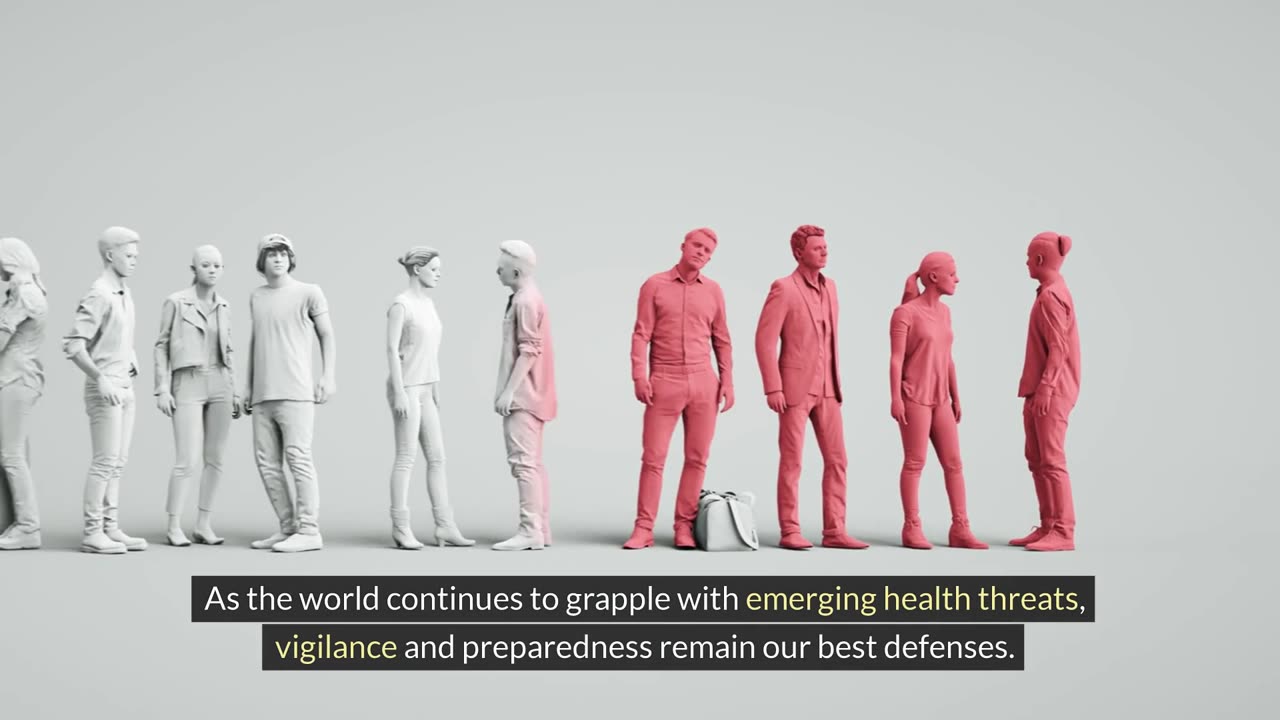Premium Only Content

Mpox Unveiled: Understanding the Virus Behind the Outbreaks
# Mpox Unveiled: Understanding the Virus Behind the Outbreaks
## The Silent Emergence of a Persistent Virus
In recent years, a virus that had long been simmering in the shadows has made its presence known on the global stage. Mpox, formerly known as monkeypox, has transitioned from a rare zoonotic disease to a significant public health concern. As new outbreaks are reported across the globe, understanding what mpox is and why it’s spreading has become crucial. This article dives deep into the origins, transmission, evolution, and the current state of mpox, highlighting why it demands our attention now more than ever.
## The Origins of Mpox: A Journey from Lab Monkeys to Humans
### Discovery and Early Cases
Mpox was first identified in 1958 in a Copenhagen laboratory, where monkeys imported from Singapore displayed symptoms of the disease. Despite its name, monkeys are not the primary reservoir of mpox. Instead, researchers suspect rodents as the primary hosts. The first human case was reported in 1970 in the Democratic Republic of Congo (DRC), involving a nine-month-old boy who lived in a rainforest area known for its monkey population. This early case underscored the zoonotic nature of the virus—its ability to jump from animals to humans.
### The Unseen Spread
For decades, mpox remained relatively obscure, with sporadic cases primarily in Africa. It wasn't until a 2003 outbreak in the United States, linked to pet prairie dogs infected by rodents imported from Ghana, that mpox gained wider attention. This outbreak illustrated how interconnected the world had become, setting the stage for more recent global concerns.
## The Recent Surge: Understanding the New Wave of Outbreaks
### Global Outbreaks and Their Impact
Since May 2022, mpox has spread beyond its traditional confines, with outbreaks reported in the US, UK, Australia, Europe, and Canada. These outbreaks, though fewer in number compared to those in Africa, have alarmed health authorities and scientists. The Democratic Republic of Congo, in particular, has been hard-hit, with over 19,000 cases and 900 deaths since January 2023. The virus strains involved, particularly clade I in the DRC, are more virulent than the clade II strains seen in recent Western outbreaks.
### The Genetic Puzzle
Genetic analysis has revealed that the recent outbreaks are linked to a variant of mpox from West Africa. This variant, possibly circulating undetected outside Africa for years, has accumulated mutations that enhance its transmissibility among humans. Preliminary research suggests that these changes may date back to as early as 2017, highlighting the virus's evolving nature and the need for vigilant monitoring.
## Transmission Dynamics: How Mpox Spreads
### Routes of Transmission
Unlike the highly contagious COVID-19, which spreads through respiratory droplets, mpox primarily requires close physical contact for transmission. This can occur through contact with infectious rashes, lesions, scabs, or bodily fluids. Contaminated items, such as clothing or bedding used by an infected person, can also facilitate the spread. While mpox DNA has been found in semen, it remains unclear if sexual transmission is a primary route.
### Community-Specific Spread
A notable aspect of the 2022 mpox outbreaks is their prevalence in men who have sex with men (MSM). Between April and June 2022, 98% of infections in 16 countries were in MSM. This pattern likely reflects the introduction and spread within a close-knit community rather than a unique susceptibility. It underscores the importance of targeted public health messaging and interventions.
## The Clinical Picture: Symptoms and Severity
### What to Expect
Mpox is a deeply unpleasant disease with a notable mortality rate. Symptoms typically appear 6-13 days after infection and begin with fever, headaches, muscle aches, and fatigue. Swelling of lymph nodes is a distinguishing feature. Soon after, a multi-stage rash develops, evolving into pus-filled blisters that can appear on the face, hands, feet, and genital regions. Recovery takes three to four weeks, with scarring common in survivors.
### Comparative Severity
The West African strain causing recent outbreaks tends to result in milder disease compared to the Central African strain. Despite a lower mortality rate, the disease's painful and debilitating nature makes it a serious public health issue. With no specific treatment available, supportive care focuses on alleviating symptoms.
## Evolution of the Virus: The Path to Increased Transmissibility
### Genetic Stability and Mutations
Mpox is a DNA virus, generally more stable and less prone to rapid mutation compared to RNA viruses like SARS-CoV-2. However, since 2018, the virus has accumulated numerous mutations, some of which have been linked to enhanced human-to-human transmission. Most of these mutations are "silent," not altering the viral proteins. Nonetheless, the sheer number of changes is surprising and indicative of the virus’s adaptive potential.
### Emerging Variants and Future Risks
Researchers have identified distinct mpox lineages and new variants, particularly in the DRC. These findings suggest that mpox may continue to evolve, potentially altering its pathogenicity. Continuous genetic surveillance is essential to detect and respond to these changes promptly.
## Global Health Implications: Lessons from the Pandemic
### The Need for Vigilance
The World Health Organization (WHO) has declared mpox a global health emergency, emphasizing the need for a coordinated international response. The cessation of routine smallpox vaccinations has left the global population with waning immunity to related viruses like mpox. This vulnerability highlights the importance of maintaining stockpiles of smallpox vaccines, which are effective against mpox.
### Equitable Access to Resources
The mpox outbreaks have spotlighted disparities in global health responses. While wealthy nations have replenished their vaccine supplies, endemic regions in Africa continue to face resource shortages. This inequity calls for a more inclusive approach to global health, ensuring that all affected regions receive the necessary diagnostics, treatments, and vaccines.
## Preparing for the Future
Mpox serves as a stark reminder of the ever-present threat of zoonotic diseases. As human activity encroaches on natural habitats and climate change alters ecosystems, the risk of new diseases emerging remains high. The global response to mpox, informed by lessons from the COVID-19 pandemic, must be swift, coordinated, and inclusive. Investing in disease monitoring, improving public health infrastructure, and ensuring equitable access to healthcare resources are critical steps in safeguarding against future outbreaks. Only through a concerted global effort can we hope to prevent the next pandemic.
-
 4:00:42
4:00:42
Badlands Media
10 hours agoThe Narrative Ep. 35: Codex of Truth
70.2K40 -
 3:55:56
3:55:56
Due Dissidence
13 hours agoSchmuley TRASHES Shapiro, Maxwell Sings For Pardon, Uhuru Doc Preview - Live From St. Louis!
33.8K38 -
 LIVE
LIVE
Lofi Girl
2 years agolofi hip hop radio 📚 - beats to relax/study to
373 watching -
 2:23:21
2:23:21
PandaSub2000
5 days agoMadison VR (Part 4) | PSVR 2000 (Original Live Version)
14.4K2 -
 2:34:32
2:34:32
Badlands Media
5 days agoCODEX 9/11
284K249 -
 1:53:43
1:53:43
Nerdrotic
7 hours ago $0.29 earnedMysteries of 3I/ATLAS | Forbidden Frontier #113
47K5 -
 2:04:21
2:04:21
vivafrei
1 day agoEp. 278: D.C. Peace Wave! Big Tish & Nipple Judge SPANKED! "Maryland Man" Trafficker FREE & MORE?
101K127 -
 3:02:42
3:02:42
Damysus Gaming
4 hours agoBorderlands 3 - Part 8 - FL4K Time | Children of the Vault be Warned!
17.5K -
 1:30:28
1:30:28
Patriots With Grit
7 hours agoWhat You Should Know About Harmful Vaccine Ingredients And What To Say To Your Doctor, Pediatrician, Health Department or School When They Pressure You, Your Kids Or Your Family Members | Dr. Bryan Ardis, D.C.
15.5K8 -
 2:21:12
2:21:12
This is the Ray Gaming
3 hours ago $0.02 earnedSunday Night Live with the Boys | Rumble Premium Creator
8.64K